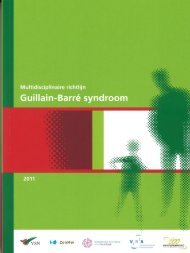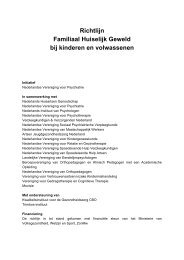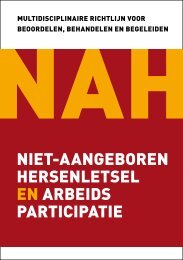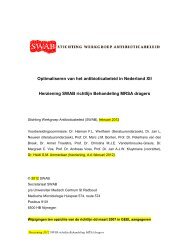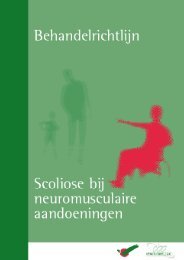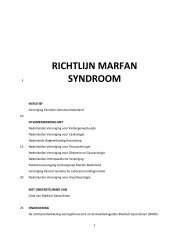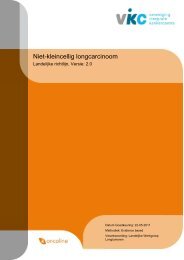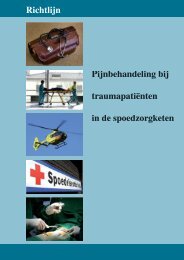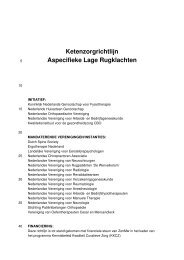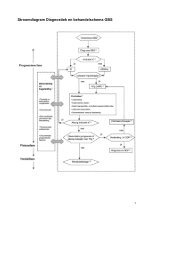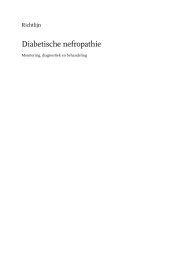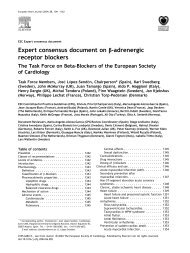Richtlijn: Otitis Externa - Kwaliteitskoepel
Richtlijn: Otitis Externa - Kwaliteitskoepel
Richtlijn: Otitis Externa - Kwaliteitskoepel
You also want an ePaper? Increase the reach of your titles
YUMPU automatically turns print PDFs into web optimized ePapers that Google loves.
or a nonaqueous viscous medication. A wick should not be made of a simple cotton ball since the<br />
cotton can fall apart and become lodged in the ear canal.<br />
Many treatment studies uniformly use a wick to improve drug delivery, but there are no trials of wick<br />
efficacy. Consequently, the benefit of a wick is questioned by some clinicians, especially in managing<br />
uncomplicated AOE. However, following first principles, if the anatomy (narrow or edematous canal)<br />
makes delivery of the topical medicine problematic, the use of a wick seems prudent. A wick is<br />
unnecessary once the ear canal edema subsides, which may occur within 24 hours (Lucente 1995) or<br />
a few days of topical therapy. The wick may fall out spontaneously, may be removed by the patient,<br />
or may be removed by a clinician at a scheduled follow-up visit.<br />
Conclusies<br />
Level of evidence 4<br />
Expert opinion<br />
Level of evidence 4<br />
Expert opinion<br />
Level of evidence 4<br />
Expert opinion<br />
Level of evidence 3<br />
Agius 1994<br />
Level of evidence 3<br />
England 2000<br />
Ototopical drops should be applied with the patient lying down and the<br />
affected ear upward. Drops should be run along the side of the canal until it<br />
is filled. The amount required will vary with the age and size of the patient.<br />
Gentle to-and-fro movement of the pinna is often necessary to eliminate<br />
trapped air and to assure filling. The patient should remain in this position<br />
for about 3 to 5 minutes.<br />
A wick can be placed when the ear canal is blocked as a result of oedema.<br />
The wick is preferably made of cellulose (Merocel) or ribbon gauze.<br />
When the edema subsides the wick can be removed.<br />
The aural toilet contributes to the topical treatment of acute otitis externa.<br />
Topical treatment should preferably be administered by someone other than<br />
the patient.<br />
Patients tend to undermedicate themselves at the end of the treatment<br />
period.<br />
Overwegingen<br />
Een tampon wordt geplaatst teneinde bij een afgesloten gehoorgang als gevolg van oedeem<br />
medicatie toch ter plaatse te krijgen. Daarnaast is het soms pas na ontzwelling mogelijk goed<br />
otoscopisch onderzoek te verrichten en de juiste diagnose te stellen.<br />
Aanbeveling<br />
De patiënt dient goed geïnstrueerd te worden over het toedienen van de topische behandeling. De<br />
patiënt moet een liggende houding aannemen, met het aangedane oor naar boven. Deze houding<br />
dient na toediening nog 3-5 minuten te worden gecontinueerd. De druppels worden bij voorkeur<br />
door iemand anders dan de patiënt toegediend.<br />
Wanneer de gehoorgang geobstrueerd is dient een oortoilet plaats te vinden, eventueel kan er ook<br />
een oortampon worden geplaatst, of beide. Indien een tampon geplaatst wordt, ligt het in de lijn der<br />
verwachting dat ontzwelling binnen 24 tot 48 is opgetreden.<br />
Referenties<br />
• Agius AM, Reid AP, Hamilton C. Patient compliance with short-term topical aural antibiotic<br />
therapy. Clin Otolaryngol 1994;19:138–41.<br />
• Balen van FAM, Smit WM, Zuithoff NPA, et al. Clinical efficacy of three common treatments<br />
in acute otitis externa in primary care: randomised controlled trial. BMJ 2003; 327:1201–3.<br />
31 <strong>Richtlijn</strong> <strong>Otitis</strong> <strong>Externa</strong> 2010<br />
Nederlandse Vereniging voor Keel-Neus-Oorheelkunde en Heelkunde van het Hoofd-Halsgebied




